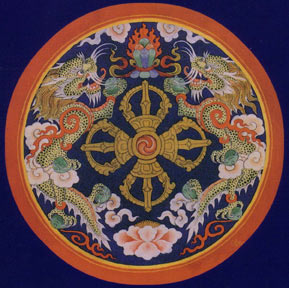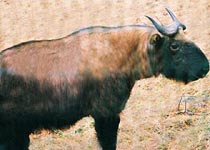 |
 |
|
 |
| National Symbols of Bhutan |
|
Uzha
Jarog Dongchen is the Raven Crown of Bhutan, a symbol of Mahakala,
the protective deity of the first Zhabdrung. The head of a raven lies on
top of a motif called Jachung, embroidered on the brim of the crown.
A sun and moon on the dead of the raven symbolize longevity., steadfastness
and enlightenment. The Norbu, also in the head, is a sacred gem
symbolic of the fulfillment of right effor
The
national emblem is contained in a circle with two dragons framing a double
diamond - thunderbolt (dorji) placed above a lotus, surmounted by
a jewel. The dorji symbolizes harmony between secular and religious power
while the jewel represents sovereign power. The quality of purity is presented
in the lotus. The two dragons, male and female, call out the name of the
country with their thunderous voice.
The national flag of Bhutan is representative of the country's general features. The secular authority of the king is shown by the upper half of the flag, which is yellow, the color of fruitful action in state and religious affairs. The lower orange half of the flag represents the religious practice and spiritual power of Mahayana Buddhism. The thunder dragon running diagonally across the middle of the flag signifies the name Druk Yul. Its white color is an expression of purity and loyalty of the various ethnic and linguistic groups in the country. The country's wealth and perfection are the jewels clasped in the dragon's claws, protected by the strength of the deities expressed by the snaring mouth of the dragon. |

The Royal Crest |
|
December
17th is celebrated throughout the country as Gyal Yung Duechhen or
National Day. It was on this day in 1907 that the country was united under
a central authority with the crowning of Ugyen Wangchuck as the first hereditary
king of Bhutan.
The
government has declared October 21st as a national holiday on the
occasion of the formal accession of His Royal Highness the Crown Prince
Jigme Khesar Namgyel Wangchuck as Chhoetse Penlop.
The
national dress of Bhutan is called the 'Gho' for men and 'Kira' for
women. It was introduced during the 17th century by Zhabdrung Ngawang Namgyal
to give the Bhutanese a unique identity. In an effort to preserve and promote
its cultural heritage, all Bhutanese are required to wear the national
dress in government offices, schools and on formal occasions. The gho is
a long robe hoisted to the knee and held in place with a 'Kera,' a
woven cloth belt, wound tightly around the waist. This forms a large pouch
above that may be used to contain particular items, traditionally a bowl
and betel nut. The kira is a floor-length rectangular piece of cloth wrapped
around the body over a blouse called wonju. The kira is held from the shoulders
by broach-like hooks called 'Koma' and is fastened at the waist with a
kera. The dress is complete with a short, open jacket-like garment called
'Toego.'
The
national sport of Bhutan is archery. It is an exclusively male sport although
women are as much part of the whole affair for their participation in the
rituals of dancing and verbal encouragements that accompany the game. Sarcastic
refrains are often made about the archers in an attempt to distract them
from hitting a straight arrow. Traditional bows and arrows are made from
although the popularity of the foreign compound bows is gaining momentum
amongst those who can afford it.
 |
|
The
Raven, Bhutan's national bird, is depicted on the crown of the king as
representative of Jarog Dongchen who, along with Yeshey Gonpo (Mahakala)
and Palden Lhamo (Mahakali) constitute the most powerful deities of the
country. As the Divine Trinity, they safeguarded the well - being of the
kingdom and protect the king and people from harm.
The
blue poppy (Meconopsis grandis) is known as 'Euitgel Metog Hoem' in Bhutan.
It was once considered to be myth because of its unconfirmed existence.
Poppies are found along high mountain passes from the far eastern parts
of the country across to the wes.
The Bhutanese consider the cypress tree sacred and identify with it for its nature and ability to survive in difficult terrain. As the national tree, it is held in great reverence. It is often planted outside monasteries, dzongs and religious places.
|
|